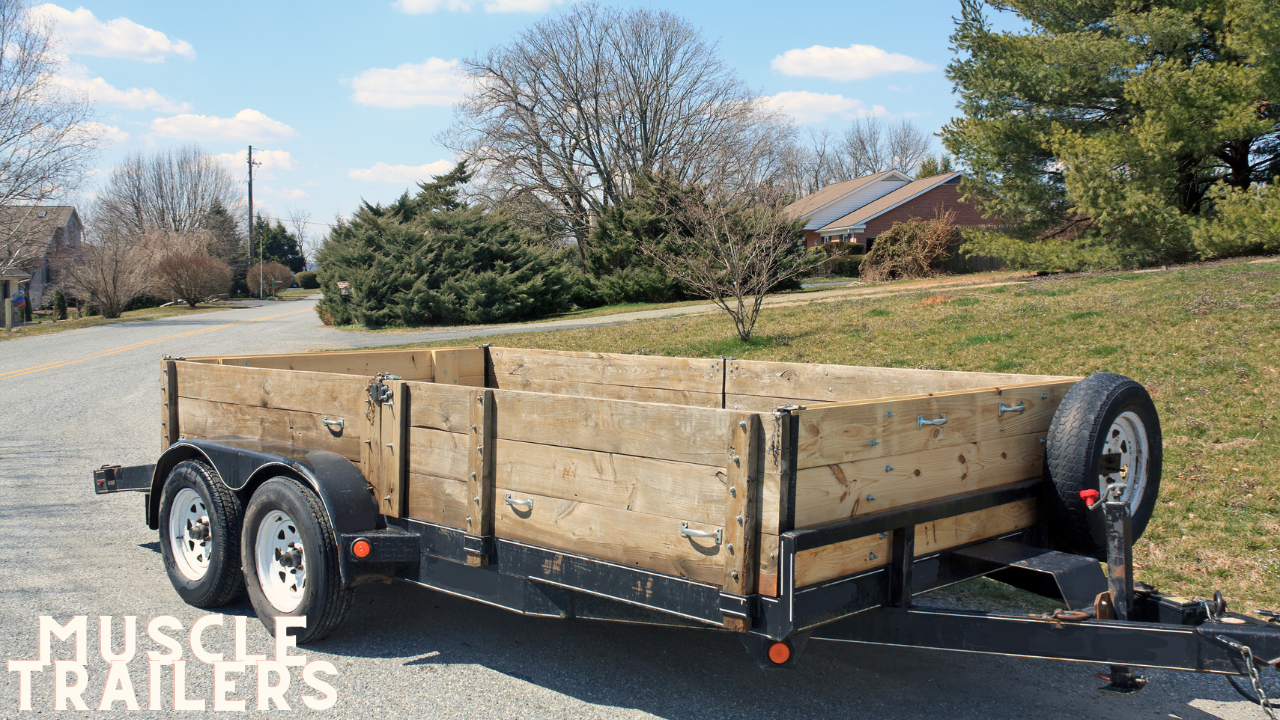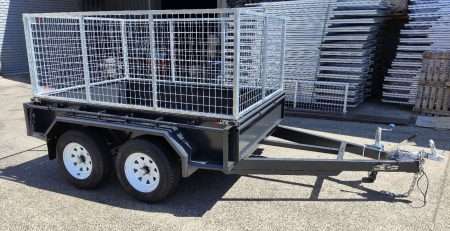
Built to Last: Unleashing the Power of Heavy-Duty Tandem Trailers
Understanding Heavy-Duty Tandem Trailers
Tandem trailers, also known as tandem axle trailers, are a type of trailer equipped with two axles that provide increased stability and weight-bearing capacity compared to single axle trailers. These heavy-duty trailers are designed to handle demanding towing tasks and can accommodate heavier loads with ease. Let’s explore what tandem trailers are and the benefits they offer.
What Are Tandem Trailers?
Tandem trailers are specifically designed to distribute the weight of the load across two axles, making them capable of carrying heavier loads compared to single axle trailers. The use of two axles provides improved stability and reduces the risk of trailer sway, ensuring safer and more controlled towing. The dual axle setup helps to distribute the weight more evenly, reducing tire wear and increasing the overall lifespan of the trailer (Trailer Superstore).
These versatile trailers come in various sizes and configurations to suit different hauling needs. Tandem trailers are commonly used in industries such as construction, landscaping, and agriculture due to their ability to carry heavy loads and withstand rough conditions.
Benefits of Heavy-Duty Tandem Trailers
The use of heavy-duty tandem trailers offers several benefits for towing heavy loads:
- Increased Stability: The dual axle setup of tandem trailers provides enhanced stability during towing. The weight distribution across two axles reduces the risk of trailer sway and improves handling, allowing for safer and more controlled maneuvering (Trailer Superstore).
- Weight-Bearing Capacity: Due to the weight distribution that two axles provide, tandem trailers are capable of towing heavier loads. The additional axle helps to distribute the load more evenly, reducing strain on the tires and other trailer components. This makes tandem trailers suitable for hauling construction equipment, livestock, and other heavy cargo (Trailer Superstore).
- Durability: Heavy-duty tandem trailers are built to withstand demanding towing conditions. They are constructed with robust materials and designed to handle heavy loads, ensuring long-lasting performance and durability.
When considering a heavy-duty tandem trailer, it’s important to evaluate factors such as tandem trailer weight capacity, tandem trailer dimensions, tandem trailer suspension, and tandem trailer brakes. These factors will help ensure that the trailer meets your specific hauling needs.
By understanding the concept of tandem trailers and their benefits, you can make an informed decision when choosing a heavy-duty trailer for your towing requirements. Whether you need to transport equipment, livestock, or other heavy cargo, a tandem trailer offers the stability and weight-bearing capacity necessary for a successful towing experience.
Features and Specifications of Tandem Trailers
When it comes to heavy-duty towing, tandem trailers are built to handle the task with ease. These trailers are equipped with two axles, providing increased stability and weight-bearing capacity compared to single axle trailers (Trailer Superstore). Let’s explore some key features and specifications of tandem trailers:
Stability and Weight-Bearing Capacity
One of the primary advantages of tandem trailers is their enhanced stability. The dual axle setup reduces the risk of trailer sway and improves handling while towing heavy loads (Trailer Superstore). The weight distribution provided by the two axles also allows tandem trailers to carry heavier loads compared to single axle trailers. This makes them suitable for hauling construction equipment, livestock, and other heavy cargo.
To ensure optimal stability and weight-bearing capacity, it’s important to choose a tandem trailer with the appropriate weight rating. Tandem trailers come in various weight capacities to accommodate different hauling needs. It’s crucial to consider the combined weight of the trailer and its cargo to ensure that it falls within the specified weight limits.
Tire Wear and Lifespan
The dual axle setup of tandem trailers not only enhances stability but also helps distribute the weight more evenly. This even weight distribution reduces tire wear and increases the overall lifespan of the trailer (Trailer Superstore). By spreading the load across multiple tires, tandem trailers minimize the strain on individual tires, allowing them to wear more slowly and evenly.
Proper tire maintenance is crucial for maximising the lifespan of tandem trailer tyres. Regularly inspecting the tires for signs of wear and maintaining the recommended tyre pressure are essential steps to ensure safe and efficient towing. It’s also crucial to take into account the load rating of the tires and make sure they are appropriate for the weight the trailer is carrying.
By utilising tandem trailers with their enhanced stability and weight-bearing capacity, you can confidently transport heavy loads while minimising the risk of trailer sway or tire wear. Whether you’re in the construction, landscaping, or agricultural industry, a heavy-duty tandem trailer is a reliable choice for hauling heavy cargo in demanding conditions.
Applications of Heavy-Duty Tandem Trailers
Heavy-duty tandem trailers are versatile workhorses that find applications in various industries and use cases. Their robust construction and ability to carry heavy loads make them indispensable for a wide range of tasks. Let’s explore some of the industries and use cases where these trailers shine, particularly in the context of construction and agricultural equipment.
Industries and Use Cases
Construction Industry
In the construction industry, heavy-duty tandem trailers play a critical role in transporting construction equipment, materials, and supplies to job sites. These trailers are specifically designed to withstand the rigors of construction environments and are built to endure heavy loads, rough terrains, and demanding conditions.
From hauling excavators, bulldozers, and loaders to transporting scaffolding, steel beams, and construction debris, tandem trailers provide the necessary strength and stability for efficient operations. The ability to carry heavy equipment and materials in a single trip saves time, increases productivity, and reduces transportation costs.
Agricultural Industry
Heavy-duty tandem trailers also find widespread use in the agricultural sector. Farmers and ranchers rely on these trailers to transport livestock, feed, hay, and farm machinery. Even when hauling hefty loads, tandem trailers’ two axles’ weight distribution ensures better stability and control.
When it comes to transporting livestock, such as cattle or horses, the safety and well-being of the animals are of utmost importance. Heavy-duty tandem trailers equipped with appropriate features like reinforced side panels, divider gates, and proper ventilation ensure the secure and comfortable transportation of animals.
Furthermore, tandem trailers are invaluable for hauling farm machinery, including tractors, harvesters, and balers. These trailers provide the necessary weight-bearing capacity to accommodate the size and weight of agricultural equipment, enabling farmers to efficiently move their machinery between fields or repair shops.
By leveraging the durability and versatility of heavy-duty tandem trailers, the construction and agricultural industries can optimise their operations, enhance productivity, and streamline logistical processes.
For more information on tandem trailers, their features, and specifications, refer to our previous sections on Understanding Heavy-Duty Tandem Trailers and Features and Specifications of Tandem Trailers.
Considerations for Towing Tandem Trailers
When it comes to towing tandem trailers, there are a few important considerations to keep in mind to ensure safe and efficient operation. Maneuverability and turning radius, as well as safety and weight distribution, play crucial roles in the towing process.
Manoeuvrability and Turning Radius
Tandem trailers require a larger turning radius compared to single axle trailers, which can make maneuvering in tight spaces more challenging (Trailer Superstore). It’s important to take this into account when navigating corners, parking, or reversing with a tandem trailer attached. Allowing for the extended length and width of the trailer during turns can help prevent potential accidents or damage to the trailer and surrounding objects.
Safety and Weight Distribution
Proper weight distribution is crucial for safe towing and optimal performance of tandem trailers. Imbalanced loads and larger loads can pose safety risks, especially when it comes to weight limits imposed by state regulations. Overloading a tandem trailer can cause damage to roadways and increase the risk of accidents.
The dual axle setup of tandem trailers helps to distribute the weight more evenly, reducing tire wear and increasing the overall lifespan of the trailer (Trailer Superstore). However, it’s essential to ensure that the weight is properly distributed between the axles and within the weight capacity limits of the trailer. Putting heavier items closer to the axles and avoiding placing too much weight on the front or back of the trailer will help achieve this.
To determine the appropriate weight distribution, it is necessary to understand the maximum weight capacity of the trailer and adhere to legal weight limits. Different states have variations in weight limits, and exceeding these limits can result in fines, increased insurance rates, and even the impoundment of the vehicle (ATS). It is crucial to familiarise yourself with the weight regulations in your state and ensure compliance to avoid legal consequences.
By considering manoeuvrability and turning radius, as well as safety and weight distribution, you can safely and effectively tow heavy-duty tandem trailers. Remember to always adhere to weight regulations, distribute the load evenly, and allow for a larger turning radius when manoeuvring with a tandem trailer. These considerations will help ensure a smooth and safe towing experience.
Types of Heavy-Duty Trailers
When it comes to heavy-duty tandem trailers, there are several types available to suit different transportation needs. Each type has its own unique features and advantages. Let’s explore some of the most common types of heavy-duty trailers:
Flatbed Trailers
Flatbed trailers are the most popular type of heavy-duty trailer and are often used for transporting construction materials, equipment, and machinery. These trailers have a flat, open deck, allowing for versatile loading and unloading options. Their design makes them suitable for carrying a wide range of cargo, from large machinery to building materials. The open deck also provides flexibility in securing and arranging the load. To learn more about tandem trailers, visit our tandem axle trailers section.
Drop Deck Trailers
Drop deck trailers, also known as step deck trailers or low-profile trailers, have a lower deck height compared to flatbed trailers. This makes them ideal for transporting taller loads that may exceed height restrictions on roadways. Drop deck trailers feature a step down in the middle of the trailer, creating two levels for loading and unloading. The lower deck provides clearance for taller cargo while maintaining stability during transportation. To find out more about tandem trailers, check out our tandem trailers section.
Lowboy Trailers
Lowboy trailers are specifically designed for transporting tall and heavy equipment such as bulldozers, excavators, and cranes. These trailers have a low deck height, allowing for easy loading and unloading of oversized machinery. Lowboy trailers often feature a detachable gooseneck or ramp, providing a gradual slope for equipment to be driven onto the trailer. The design ensures stability and safety during transportation. For more tandem trailers, visit our tandem trailer fenders section.
Extendable Trailers
Extendable trailers, also known as stretch trailers or telescopic trailers, offer the flexibility to adjust their length to accommodate different load sizes. These trailers are commonly used for transporting long and oversized loads such as wind turbine blades and bridge beams. By extending or retracting the trailer’s length, it can adapt to the specific dimensions of the cargo, ensuring secure transportation. Extendable trailers provide versatility for handling various load lengths. Check out our tandem utility trailers section for more information.
When selecting a heavy-duty tandem trailer, it’s important to consider the specific requirements of your cargo. Each type of trailer offers distinct advantages, such as versatility, height clearance, and adjustability. By understanding the different types available, you can choose the one that best suits your transportation needs.
Weight Limits and Regulations for Tandem Trailers
When it comes to heavy-duty tandem trailers, it’s crucial to understand the weight limits and regulations in place to ensure safe and legal operations. Let’s explore the key aspects related to weight limits and regulations for tandem trailers.
State Variations in Weight Limits
The weight limits for heavy-duty tandem trailers can vary from state to state. Some states allow up to 80,000 pounds, while others limit the weight to 34,000 pounds (ATS). These variations depend on several factors, including axle configurations, bridge formulas, and the type of highway being traveled. For example, in Colorado, the weight limit for tandem trailers is 80,000 pounds on interstate highways but only 34,000 pounds on intrastate highways (ATS).
To ensure compliance with the weight limits, it’s crucial for operators of tandem trailers to be aware of the specific regulations in each state they operate in. This helps prevent overweight violations and potential penalties.
The Bridge Formula and Weight Calculations
The Federal Highway Administration (FHWA) uses the bridge formula to calculate the maximum allowable weight for a commercial vehicle based on axle spacing and the number of axles. Its primary purpose is to protect bridges from excessive weight.
By using the bridge formula, operators can calculate the maximum allowable weight for their tandem trailers based on the dimensions and axle configurations. This helps ensure compliance with weight regulations and reduces the risk of bridge damage.
Consequences of Overweight Violations
Overweight violations for heavy-duty tandem trailers can have several consequences. Violations may result in fines, increased insurance rates, and even impoundment of the vehicle. Additionally, these violations can negatively impact a trucking company’s safety rating and compliance record (ATS).
To avoid such consequences, it’s essential to properly load and distribute weight on tandem trailers. By adhering to weight limits and regulations, operators can ensure safe and efficient transportation while maintaining compliance with legal requirements.
Understanding the weight limits and regulations for tandem trailers is vital for operators to ensure safe and legal operations. Being aware of state variations in weight limits, utilizing the bridge formula for weight calculations, and avoiding overweight violations are key factors in maintaining compliance and preventing potential penalties.
Author
I am Rahatul Ashiq Tamal. Another author of Muscle Trailers. Muscle Trailers is a well-known trailer brand in Sydney, Melbourne & Adelaide

How to Mount a Spare Tire on Your Trailer: A Simple Step-by-Step Guide
Trailer service centers receive over 1 million phone calls and 1.3 million emails each year about trailer maintenance problems....

How to Fix RV Roof Leaks: Simple Roof Leak Detection Guide for Beginners
Did you know DIY RV roof repairs can cost under $50? But undetected leaks could lead to substantially higher repair...

Starting a Food Truck Business in Australia: From Trailer Selection to Launch
The Australian mobile food market has evolved into a billion-dollar industry. This makes a food truck...
